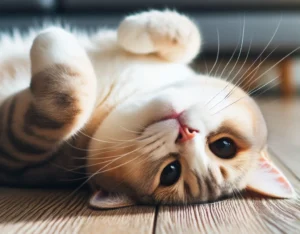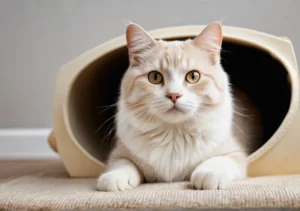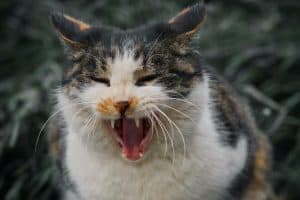Cats can exhibit some truly bizarre behaviors when they are in heat, leaving many pet owners scratching their heads in confusion. From yowling at all hours of the night to constantly rolling around on the floor, it can be hard to understand why our feline friends act so strangely during this time. So, why exactly do cats act so weird in heat?
In short, a cat’s behavior during heat is driven by their biological instincts to reproduce. When a female cat is in heat, her body releases hormones that trigger a range of unusual behaviors designed to attract a mate. From loud vocalizations to rubbing up against objects and people, these behaviors are all part of the cat’s natural drive to procreate.
What are the Signs of a Cat in Heat?
If your furry feline friend starts acting a bit strange, it might be a sign that they’re in heat. Some typical behaviors to watch out for include excessive vocalization, restlessness, rubbing against objects, and a strong desire to escape outside. You might also notice a change in their posture, with their tail held to the side and their rear raised.
Physically , a cat in heat might display some tell-tale signs such as a swollen genital area and increased grooming of their private parts. Some cats also experience a slight discharge. Remember, these behaviors can differ from cat to cat, so it’s essential to pay close attention to any unusual changes in your pet’s behavior.
How Long Does a Cat Stay in Heat?
A cat’s heat cycle typically lasts around seven to ten days, but it can vary from cat to cat. Female cats can go into heat as often as every three weeks during the breeding season, typically from spring to fall. During this time, they are highly fertile and may exhibit discomfort and irritability due to the strong urge to mate.
It’s crucial to spay or neuter your cat to prevent these repetitive heat cycles, as they can be stressful for both you and your furry friend. If you’re considering breeding your cat, it’s essential to consult with a veterinarian to ensure a safe and responsible process.
Remember, understanding your cat’s behaviors during heat can help you provide the necessary care and attention during this natural biological process. Observing and responding to your cat’s needs will ensure they remain healthy and happy throughout their heat cycle.
For more in-depth information on cat behaviors and health, you can refer to reputable sources like the American Society for the Prevention of Cruelty to Animals (ASPCA).
How Can You Help Your Cat During Heat?
When your cat is in heat, it can be a challenging time for both you and your feline friend. To help your cat through this period, create a calm and comfortable environment. Provide a quiet space where your cat can relax away from any potential stressors. Engage in interactive play to distract your cat and help burn off excess energy. Offer extra attention and affection to reassure your cat during this hormonal time.
Keep your cat indoors to prevent unwanted pregnancies and exposure to potential dangers outside. Consider using pheromone products designed to reduce stress and anxiety in cats. Schedule a veterinary appointment to discuss options for managing your cat’s heat cycle effectively.
Remember, patience is key when dealing with a cat in heat. By providing a safe and supportive environment, you can help your cat navigate this natural process with minimal disruption to your household routine.
Is Spaying or Neutering the Best Solution?
When it comes to addressing your cat’s heat cycles, spaying or neutering is often the most effective solution. Spaying, the surgical removal of a female cat’s reproductive organs, eliminates heat cycles entirely and helps prevent unwanted litters of kittens. Neutering, the castration of male cats, reduces mating behaviors and eliminates the risk of contributing to overpopulation.
In addition to preventing heat-related behaviors, spaying or neutering your cat reduces the risk of certain reproductive cancers and extends their lifespan. It also helps lower the number of homeless cats and improves their overall quality of life.
Consider consulting with your veterinarian to discuss the benefits of spaying or neutering your cat and to determine the best course of action based on your cat’s health and individual needs. Spaying or neutering is not only a responsible choice but also a compassionate one that can positively impact your cat’s well-being for years to come.
Can Cats Experience Pain During Heat?
Cats in heat may exhibit behaviors that seem erratic or exaggerated, such as increased vocalization, restlessness, and solicitation of attention. While these behaviors can be frustrating for cat owners, it’s essential to understand that cats are not experiencing physical pain during heat. However, they may feel discomfort due to hormonal changes and the strong urge to mate.
If you notice your cat in heat displaying signs of distress, such as excessive grooming or lethargy, it’s crucial to consult with a veterinarian to rule out any underlying health issues. Providing a calm and safe environment for your cat during this time can help alleviate their discomfort and reduce stress levels.
Remember, patience and understanding are key when dealing with a cat in heat. By offering comfort and support, you can help your feline companion navigate this natural phase with minimal stress and discomfort.
What Happens if a Cat Doesn’t Mate During Heat?
If a cat doesn’t mate while in heat, they will typically go through a period known as “pseudopregnancy.” During this time, the cat may exhibit nesting behaviors, enlarged mammary glands, and even produce milk. This is a natural response to the unfulfilled mating urge.
While pseudopregnancy itself is not harmful to the cat, it can lead to certain health complications if it occurs frequently. For instance, repeated pseudopregnancies may increase the risk of mammary tumors or uterine infections. To prevent these potential health issues, it’s essential to spay your cat to avoid future heat cycles.
Spaying not only benefits your cat’s health but also helps control the pet population and reduce the number of stray cats in your community. By spaying your cat, you can ensure her well-being and contribute to a more responsible approach to pet ownership.
Additional Unique Insight : Providing your cat with interactive toys and engaging activities during heat can help distract them from the urge to mate, reducing stress and keeping them mentally stimulated. Implementing play sessions and puzzle feeders can redirect their energy in a positive way during this challenging time.
Do Male Cats Behave Differently During a Female’s Heat Cycle?
Male cats can exhibit significant changes in behavior when a female cat is in heat. They may become more vocal, agitated, and restless as they pick up on the scent of the female in heat. Some male cats may even spray urine to mark their territory in an attempt to attract the female. It’s essential to keep male and female cats separated during this time unless breeding is desired to avoid unwanted pregnancies.
Moreover, male cats may constantly vocalize their desire to mate, leading to loud, persistent meowing that can be quite disruptive. It’s important to ensure male cats are neutered to prevent unwanted mating behaviors and minimize the stress caused by a female cat in heat.
Fun Facts About Cats in Heat
Purring Contradiction: While cats are often associated with relaxation and contentment when they purr, female cats in heat may also purr loudly as a part of their mating behavior. This can be confusing for cat owners who are used to interpreting purring as a sign of happiness.
Temperature Regulation: Female cats in heat may exhibit strange behaviors like rolling on the floor or seeking out cooler surfaces. This is because the increase in their body temperature during heat cycles can make them uncomfortable, leading them to find ways to cool down.
Cycle Frequency: Female cats typically go into heat every two to three weeks during the breeding season, which can vary depending on factors such as daylight hours and temperature. Understanding this cycle can help cat owners prepare for and manage their cat’s heat periods effectively.
For additional information on managing cat behavior during heat cycles, you can visit the American Society for the Prevention of Cruelty to Animals (ASPCA) website: ASPCA – Cat Heat Cycles.
Alex, a passionate animal lover, has experience in training and understanding animal behavior. As a proud pet parent to two dogs and three cats, he founded AnimalReport.net to share insights from animal experts and expand his knowledge of the animal kingdom.




